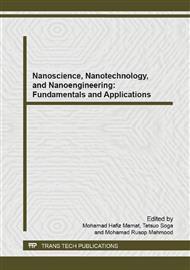p.304
p.309
p.314
p.319
p.324
p.328
p.333
p.340
p.345
Electrical Conductivity and Structural Studies on the Binary Solid State Li2WO4-LiI-Al2O3 Electrolyte
Abstract:
The binary solid electrolyte Li2WO4-LiI with incorporation of nanosize Al2O3 was prepared in solid state reaction and characterized by Electrical Impedance Spectroscopy (EIS), Field Emission Scanning Electron Microscopy (FESEM) and Fourier Transform Infrared (FTIR) spectroscopy. Maximum electrical conductivity of 3.35x10-3 Scm-1 was recorded for the sample containing 20 wt. % of LiI. Enhancement of electrical conductivity up to 5.8x10-3Scm-1 was achieved when 0.5 wt. % of Al2O3 was added into the optimum composition of the binary Li2WO4-LiI system. Tetrahedral structure of WO4 that appear at wave number of 906 cm-1 and 955 cm-1 in the FTIR spectroscopy confirmed. The existence of conducting pathway for migrations of Li ions in system that contributes to high electrical conductivity.
Info:
Periodical:
Pages:
324-327
Citation:
Online since:
June 2015
Authors:
Price:
Сopyright:
© 2015 Trans Tech Publications Ltd. All Rights Reserved
Share:
Citation:


